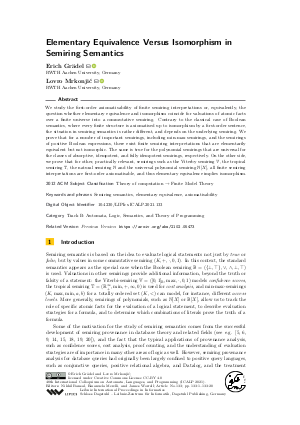Elementary Equivalence Versus Isomorphism in Semiring Semantics
Authors
Erich Grädel  ,
Lovro Mrkonjić
,
Lovro Mrkonjić 
-
Part of:
Volume:
48th International Colloquium on Automata, Languages, and Programming (ICALP 2021)
Part of: Series: Leibniz International Proceedings in Informatics (LIPIcs)
Part of: Conference: International Colloquium on Automata, Languages, and Programming (ICALP) - License:
 Creative Commons Attribution 4.0 International license
Creative Commons Attribution 4.0 International license
- Publication Date: 2021-07-02
File

PDF
LIPIcs.ICALP.2021.133.pdf
- Filesize: 0.79 MB
- 20 pages
Document Identifiers
Related Versions
- Previous Version https://arxiv.org/abs/2102.05473
Subject Classification
ACM Subject Classification
- Theory of computation → Finite Model Theory
Keywords
- Semiring semantics
- elementary equivalence
- axiomatisability
Metrics
- Access Statistics
-
Total Accesses (updated on a weekly basis)
0Document
0Metadata
Abstract
We study the first-order axiomatisability of finite semiring interpretations or, equivalently, the question whether elementary equivalence and isomorphism coincide for valuations of atomic facts over a finite universe into a commutative semiring. Contrary to the classical case of Boolean semantics, where every finite structure is axiomatised up to isomorphism by a first-order sentence, the situation in semiring semantics is rather different, and depends on the underlying semiring. We prove that for a number of important semirings, including min-max semirings, and the semirings of positive Boolean expressions, there exist finite semiring interpretations that are elementarily equivalent but not isomorphic. The same is true for the polynomial semirings that are universal for the classes of absorptive, idempotent, and fully idempotent semirings, respectively. On the other side, we prove that for other, practically relevant, semirings such as the Viterby semiring 𝕍, the tropical semiring 𝕋, the natural semiring ℕ and the universal polynomial semiring ℕ[X], all finite semiring interpretations are first-order axiomatisable, and thus elementary equivalence implies isomorphism.
Cite As Get BibTex
Erich Grädel and Lovro Mrkonjić. Elementary Equivalence Versus Isomorphism in Semiring Semantics. In 48th International Colloquium on Automata, Languages, and Programming (ICALP 2021). Leibniz International Proceedings in Informatics (LIPIcs), Volume 198, pp. 133:1-133:20, Schloss Dagstuhl – Leibniz-Zentrum für Informatik (2021)
https://doi.org/10.4230/LIPIcs.ICALP.2021.133
BibTex
@InProceedings{gradel_et_al:LIPIcs.ICALP.2021.133,
author = {Gr\"{a}del, Erich and Mrkonji\'{c}, Lovro},
title = {{Elementary Equivalence Versus Isomorphism in Semiring Semantics}},
booktitle = {48th International Colloquium on Automata, Languages, and Programming (ICALP 2021)},
pages = {133:1--133:20},
series = {Leibniz International Proceedings in Informatics (LIPIcs)},
ISBN = {978-3-95977-195-5},
ISSN = {1868-8969},
year = {2021},
volume = {198},
editor = {Bansal, Nikhil and Merelli, Emanuela and Worrell, James},
publisher = {Schloss Dagstuhl -- Leibniz-Zentrum f{\"u}r Informatik},
address = {Dagstuhl, Germany},
URL = {https://drops.dagstuhl.de/entities/document/10.4230/LIPIcs.ICALP.2021.133},
URN = {urn:nbn:de:0030-drops-142022},
doi = {10.4230/LIPIcs.ICALP.2021.133},
annote = {Keywords: Semiring semantics, elementary equivalence, axiomatisability}
}
Author Details
References
- C. Bourgaux, A. Ozaki, R. Peñaloza, and L. Predoiu. Provenance for the description logic ELHr. In Proceedings of IJCAI 2020, pages 1862-1869, 2020. URL: https://doi.org/10.24963/ijcai.2020/258.
- K. Dannert and E. Grädel. Provenance analysis: A perspective for description logics? In C. Lutz et al., editor, Description Logic, Theory Combination, and All That, Lecture Notes in Computer Science Nr. 11560. Springer, 2019. URL: https://doi.org/10.1007/978-3-030-22102-7_12.
-
K. Dannert and E. Grädel. Semiring provenance for guarded logics. In Hajnal Andréka and István Németi on Unity of Science: From Computing to Relativity Theory through Algebraic Logic, Outstanding Contributions to Logic. Springer, 2020.

-
K. Dannert, E. Grädel, M. Naaf, and V. Tannen. Semiring provenance for fixed-point logic. In Proceedings of CSL 2021, 2021.

-
D. Deutch, T. Milo, S. Roy, and V. Tannen. Circuits for datalog provenance. In Proc. 17th International Conference on Database Theory ICDT, pages 201-212, 2014.

- J. Doleschal, B. Kimelfeld, W. Martens, and L. Peterfreund. Weight annotation in information extraction. In International Conference on Database Theory, ICDT 2020, 2020. URL: https://doi.org/10.4230/LIPIcs.ICDT.2020.8.
-
M. Droste and P. Gastin. Weighted automata and weighted logics. In International Colloquium on Automata, Languages, and Programming, pages 513-525. Springer, 2005.

-
M. Droste and W. Kuich. Semirings and formal power series. In Handbook of Weighted Automata, pages 3-28. Springer, 2009.

-
F. Geerts and A. Poggi. On database query languages for K-relations. Journal of Applied Logic, 8(2):173-185, 2010.

-
J. Goodman. Semiring parsing. Computational Linguistics, 25:573-605, 1999.

-
E. Grädel and Y. Gurevich. Metafinite model theory. Information and Computation, 140:26-81, 1998.

- E. Grädel and V. Tannen. Semiring provenance for first-order model checking. arXiv:1712.01980 [cs.LO], 2017. URL: http://arxiv.org/abs/1712.01980.
- E. Grädel and V. Tannen. Provenance analysis for logic and games. Moscow Journal of Combinatorics and Number Theory, 9(3):203-228, 2020. URL: https://doi.org/10.2140/moscow.2020.9.203.
-
T. Green, G. Karvounarakis, and V. Tannen. Provenance semirings. In Principles of Database Systems PODS, pages 31-40, 2007.

-
T. Green and V. Tannen. The semiring framework for database provenance. In Proceedings of PODS, pages 93-99, 2017.

-
L. Hella. Logical hierarchies in PTIME. In Proceedings of LICS 92, pages 360-368, 1992.

-
M. Naaf. Semirings for Provenance Analysis of Fixed Point Logics and Games. Msc thesis, RWTH Aachen University, 2019.

-
A. Ozaki and R. Peñaloza. Provenance in ontology-based data access. In Description Logics 2018, volume 2211 of CEUR Workshop Proceedings, 2018.

- M. Raghothaman, J. Mendelson, D. Zhao, M. Naik, and B. Scholz. Provenance-guided synthesis of datalog programs. Proc. ACM Program. Lang., 4:62:1-62:27, 2020. URL: https://doi.org/10.1145/3371130.
-
P. Senellart. Provenance and probabilities in relational databases: From theory to practice. SIGMOD Record, 46(4):5-15, 2017.

